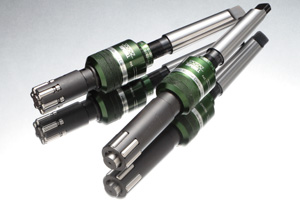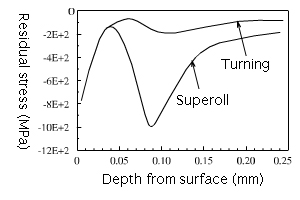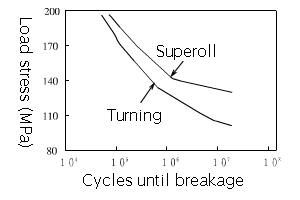Processing effect of the "Superoll" Roller Burnishing Tools
Effect of “Superoll” processing
 By improving the roughness of the processed surface with Superoll processing, the following effects can also be obtained at the same time.
By improving the roughness of the processed surface with Superoll processing, the following effects can also be obtained at the same time.
- Improvement of fatigue strength
- Extended lifetime of sliding parts
- Environmental measures
- Reduction in early wear
- Sealing improvement
Improvement of fatigue strength
Superoll processing improves the roughness of the surface and, at the same time, generates compressive residual stress, improving fatigue strength.
Figure 1 is a graph that compares the residual stress distribution between lathe processed parts and Superoll processed parts for the SUS304 material. It shows that the compressive residual stress of the Superoll processed parts reaches the peak when entering inside at a depth of only 0.08 to 0.10 mm where shearing stress is at a maximum.
Figure 2 shows the result from the internal pressure fatigue destruction test with the same samples. The compressive residual stress from the circumferential direction generated inside the material by Superoll processing reduces cracks from occurring near the fatigue limit and improves fatigue strength by about 30%.
Figure 1. Distribution of residual stress

Figure 2. Changes in the SN-curve by residual stress

![]()
Extended lifetime of sliding parts
There is a resin or metal sealing such as an O-ring or packing in the sealing materials for oil pressure and pneumatic cylinders.
These sealing materials slide with the metal of the cylinder body. The sealing materials must maintain an airtight seal by adapting itself with the metal and not wear out by sliding. The profile curve of the surface completed by the cutting process, such as grinding and honing, has a raised mound area, and the seal materials will become worn out by this mound area.
In contrast, on the surface completed by Superoll processing, the mound area is smoothened and becomes a flat plateau surface (plateau shape), and the occurrence of stick-slip and wear is diminished as the contact with the sealing material becomes smoother.
This is used in the brake cylinders of vehicles, hydraulic and pneumatic cylinders, valve bodies, shock absorbers, and so on.
![]()
Environmental measures
The sliding bearing requires the roughness to be less than Rz3.2μm to minimize friction. Many materials for bearings are cast iron or nonferrous metals, and while Superoll processing easily provides a better finished surface, it also creates no industrial waste (sludge processing), such as occurs with grinding and honing, which greatly contributes to productivity and environmental measures.
![]()
Reduction in early wear
Parts and axles that fit closely together with metal and holes pressing into bushes or bearings require an excellent roughness of the surface and strict accuracy of dimension. The parts completed by cutting experience plastic deformation of the surface layer by vibration during use and repeated loads, and the parts wear out after a long period of use.
In contrast, parts that have been Superoll processed have irregular surfaces pressed and smoothened, and because the yield point is rising, the parts will not wear out over a long period of time and stable performance can be maintained.
Sealing improvement
Most valve seats used for water, oil, gas, and air are created with a tapered shape. The tapered surface requires strict accuracy of the shape and surface roughness to prevent leaking.
The surface completed by Superoll processing has enhanced surface roughness, wear resistance, and even fatigue strength; therefore, the durability and airtightness of the sealed surface is substantially improved.
![]()
